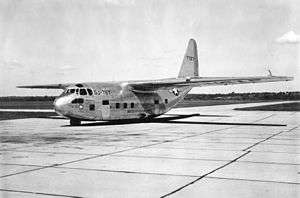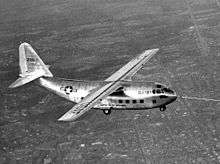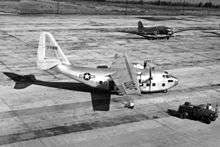Chase XCG-20
| XCG-20/XG-20 | |
|---|---|
 | |
| The second XG-20 prototype | |
| Role | Assault glider |
| Manufacturer | Chase Aircraft |
| Designer | Michael Stroukoff |
| First flight | April 1950 |
| Primary user | United States Air Force |
| Number built | 2 |
| Developed into | C-123 Provider Chase XC-123A |
The Chase XCG-20, also known as the XG-20 and by the company designation MS-8 Avitruc,[1] was a large assault glider developed immediately after World War II by the Chase Aircraft Company for the United States Air Force, and was the largest glider ever built in the United States. The XG-20 did not see production due to a change in USAF requirements, however, it was modified into the successful Fairchild C-123 Provider twin-engined transport aircraft which saw extensive service in the Vietnam War.[1]
Design and development
Following the end of World War II, the United States Army Air Forces, which became the United States Air Force (USAF) in 1947, developed a requirement for a new, large assault glider type to replace smaller types that were then in service, all existing gliders having been declared obsolete.[2] The new gliders were to be constructed entirely of metal, and were also required to be easily adaptable to a powered configuration.[2] As part of a five-year development program,[2] a contract was awarded to the Chase Aircraft Company of Trenton, New Jersey, in August 1946 for the construction of two types of gliders.[3] These included a smaller model being designated XCG-18A, and the larger, definitive model being designated XCG-20.[4]
The XCG-20, redesignated XG-20 in 1948 with the establishment of the USAF, was the largest glider ever constructed in the United States, and the last combat glider to be built for the U.S. military.[5] It featured a high-mounted wing and retractable tricycle landing gear, with an auxiliary power unit supplied hydraulic power to the landing gear and flaps.[3] The nose section was reinforced to provide optimal protection to the pilots in the event of a crash on landing, and to allow for the strongest possible towing connection.[3] The cargo hold was 30 feet (9.1 m) long and 12 feet (3.7 m) wide;[3] it featured an innovative configuration, the rear fuselage being upswept with an integrated loading ramp.[4] This allowed vehicles to be driven directly on and off of the aircraft, speeding loading and unloading times.[4]
Operational history


Although the first prototype XG-20 never flew as a glider, the second prototype conducted the aircraft's first flight in April 1950.[6] Following being displayed to the public at Pope Air Force Base as part of Exercise Swarmer during that month,[7] the XG-20 underwent thorough flight testing; during the late summer, it was evaluated against a variety of other transport aircraft at Eglin Air Force Base in Florida.[8][9] Although it possessed no obvious faults, the test program confirmed that the powered "assault transport" was the equal of the glider in landing performance;[10] having been rendered obsolete, the assault glider fell out of favor with the Air Force, and the XG-20 project was cancelled.[11]
However, Chase had designed the aircraft to allow for the easy installation of engines; the first XG-20 had already been modified with two radial piston engines, becoming the XC-123, the prototype of the long-serving C-123 Provider family of transports.[12] Meanwhile, the second prototype XG-20 was returned to Chase Aircraft, to be fitted with two twin pods for General Electric J47 turbojets, becoming the XC-123A, the first jet-powered transport aircraft built in the United States.[13]
Specifications
Data from "C-123 Provider in action"[3]
General characteristics
- Crew: 3
- Length: 77 ft 1 in (23.50 m)
- Wingspan: 110 ft 0 in (33.53 m)
- Height: 33 ft 10 in (10.31 m)
- Wing area: 1,222.78 sq ft (113.600 m2)
- Airfoil: NACA 23017[14]
- Max takeoff weight: 70,000 lb (31,751 kg) limited by tow aircraft to 40,000 pounds (18,000 kg)
See also
| Wikimedia Commons has media related to Chase XG-20. |
- Related development
- Aircraft of comparable role, configuration and era
- Related lists
References
Notes
- 1 2 Gunston 1980, p. 170.
- 1 2 3 Noetzel 1992, p.27.
- 1 2 3 4 5 Adcock 1992, p.4.
- 1 2 3 Pattillo 2000, p.165.
- ↑ Sergievsky et al. 1998, p.128
- ↑ Noetzel 1992, p.28.
- ↑ Shrader 1953, p.136.
- ↑ Aviation Week, October 23, 1950, pp.11-12.
- ↑ "Assault Transport Tests Staged at Eglin Field". Fort Walton, Florida Playground News, September 7, 1950. Vol. 5, Num. 32. p.1
- ↑ "Race for Superiority: Giant Transports to Get Eglin Suitability Tests", Fort Walton, Florida Playground News, August 17, 1950. Vol. 5, Num. 29. p.9.
- ↑ Mitchell 1992, p.164.
- ↑ Andrade 1979, p. 87.
- ↑ Adcock 1992, p.7.
- ↑ Lednicer 2010
Bibliography
- Adcock, Al (1992). C-123 Provider in action. Aircraft In Action. 124. Carrollton, TX: Squadron/Signal Publications. ISBN 978-0-89747-276-0.
- Andrade, John (1979). U.S. Military Aircraft Designations and Serials since 1909. Leicester, UK: Midland Counties Publications. ISBN 0-904597-22-9.
- Gunston, Bill (1980). The Encyclopedia of the World's Air Power. New York: Crescent Books. ISBN 0-517-53754-0.
- Lednicer, David (2010). "The Incomplete Guide to Airfoil Usage". University of Illinois at Urbana-Champaign. Retrieved 2010-11-27.
- Mitchell, Kent A. (1992). "The C-123 Provider". AAHS Journal. Santa Ana, CA: American Aviation Historical Society. 37. Retrieved 2010-11-28.
- Noetzel, Jonathan C. (1992). To War on Tubing and Canvas: A Case Study in the Interrelationships Between Technology, Training, Doctrine and Organization. Maxwell AFB, AL: Air University Press. ASIN B003S6KK7Q. Retrieved 2011-01-22.
- Pattillo, Donald M. (2000). Pushing the Envelope: The American Aircraft Industry. Ann Arbor, MI: University of Michigan Press. ISBN 978-0-472-08671-9. Retrieved 2010-11-26.
- Sergievsky, Boris; Allan Forsyth; Adam Hochschild (1998). Airplanes, Women, and Song: Memoirs of a Fighter Ace, Test Pilot, and Adventurer. Syracuse, NY: Syracuse University Press. ISBN 978-0-8156-0545-4.
- Shrader, Welman Austin (1953). Fifty years of flight: a Chronicle of the Aviation Industry in America, 1903-1953. Cleveland, OH: Eaton Manufacturing Company. ASIN B0006ATK3C. Retrieved 2010-11-27.